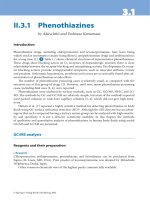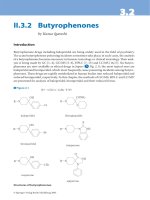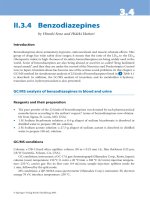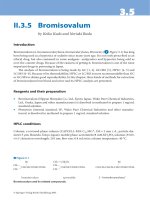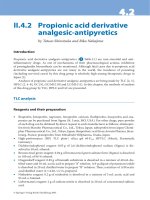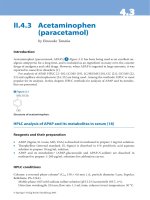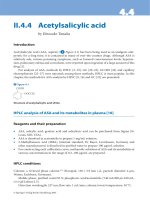Tài liệu Drugs and Poisons in Humans - A Handbook of Practical Analysis (Part 41) doc
Bạn đang xem bản rút gọn của tài liệu. Xem và tải ngay bản đầy đủ của tài liệu tại đây (95.87 KB, 4 trang )
4.94.9
© Springer-Verlag Berlin Heidelberg 2005
II.4.9 Salicylic acid
By Einosuke Tanaka
Introduction
Salicylic acid (> Figure 9.1) is being used as a keratolytic agent for treatment of corns or ver-
rucae; the acid is included in adhesive plasters, ointments and liquid medicines as their ingre-
dient for removing the stratum corneum. Since such products containing salicylic acid are
easily obtainable, salicylic acid poisoning ( salicylism) cases are relatively many especially for
infants not older than 5 years. Its poisoning symptoms were reported to be headache, vertigo,
tinnitus, bradyacusia, amblyopia and sweating [1].
For analysis of salicylic acid, HPLC methods were reported [2–7]. In this chapter, a method
for HPLC analysis of salicylic acid in serum specimens is presented [3].
Structure of salicylic acid.
⊡ Figure 9.1
Reagents and their preparation
• 8-Chlorotheophylline (internal standard, IS, Sigma, St. Louis, MO, USA) is dissolved in
ethanol to prepare 150 µg/mL solution.
• Salicylic acid (Sigma) is dissolved in methanol to prepare 5–500 µg/mL solutions.
• A 2.7-g aliquot of sodium acetate is dissolved in 1 L water, followed by addition of 15 mL
acetic acid to prepare acetate bu er solution (pH 3.6).
HPLC conditions
Column: a reversed phase column
a
, µBondapak C18 Radial-Pak (100 × 5 mm i.d., particle di-
ameter 10 µm, Waters, Milford, MA, USA).
Mobile phase: acetate bu er solution (pH 3.6)/methanol (72:28, v/v).
Detection wavelength
b
: 280 nm; ow rate: 1 mL/min: column (oven) temperature: room tem-
perature.
392 Salicylic acid
Procedure
i. A 100-µL volume of serum, 20 µL IS solution and 200 µL of 1 M hydrochloric acid solu-
tion are placed in a glass centrifuge tube with a ground-in stopper and mixed well.
ii. A 2-mL volume of dichloromethane/isopropanol (9:1, v/v) is added to the above mixture.
iii. A er mixing or shaking for 5 min, it is centrifuged at 2,500 g for 2 min.
iv. e organic layer (lower phase) is transferred to a clear test tube.
v. e organic extract is evaporated to dryness under a gentle stream of air (or nitrogen)
with warming at 50 °C.
vi. e residue is dissolved in 100 µL of the mobile phase to be used as test solution.
vii. A 20-µL aliquot of it is injected into HPLC.
viii. For constructing calibration curves, various concentrations of salicylic acid and a xed
amount of IS are processed according to the same procedure.
Assessment and some comments on the method
> Figure 9.2 shows HPLC chromatograms for the authentic standard salicylic acid and for the
extract of human serum, into which salicylic acid and IS had been spiked. In this method, the
linearity of salicylic acid was found in the range of 20–500 µg/mL; the detection limit was
3 µg/mL.
Since salicylic acid is also a main metabolite of acetylsalicylic acid, the present method can
be used for the metabolite analysis for acetylsalicylic acid (see Chapter 4 of general drugs).
Conversely, the HPLC conditions described in Chapter 4 can be also used for analysis of sali-
cylic acid. Methyl salicylate, being used as a topical analgesic-antiphlogistic drug, is also me-
tabolized into salicylic acid; therefore, the present method can be used for analysis in methyl
salicylate poisoning.
Blood therapeutic, toxic and fatal concentrations [8]
Blood therapeutic concentrations: 20–250 µg/mL; toxic concentrations: 150–500 µg/mL; fatal
concentrations: not lower than 500 µg/mL.
Poisoning case [9]
Twenty-year-old and 21-year-old brothers were su ering from ichthyosis and were by them-
selves treating their corni ed trichophytia (hyperkeratomycosis) with a drug. It was a gel drug
consisting of propylene glycol, 20% ethanol, 20% water and 6% salicylic acid. For one bandage,
about 100 g of the gel drug was applied; they continued such treatment for several years. Just
a er each treatment, they complained of noisy and continuing tinnitus. e concentration of
salicylic acid in serum sampled from the elder brother was 366 µg/mL, which was at a toxic
level. e toxic dose of salicylic acid is about 50 mg/kg. e concentration was estimated to
reach its maximum about 12 h a er topical application the gel. e body weight of above pa-
tient (elder brother) was 62 kg; about 60% (3.6 g in 100 g gel) of the total amount of the drug
393
applied was considered to be absorbed percutaneously. If this assumption is correct, his dose
per kg is calculated to be 58 mg/kg, which exceeds the above toxic dose (50 mg/kg).
Notes
a) In many reports, reversed phase octadecyl (C
18
) chemical-bonded silica gel columns with
10–15 cm lengths and 2.5–5 µm particle sizes are being used.
b) e wavelength to be used is somewhat di erent in di erent methods; the optimum wave-
length should be checked for each detector and for each mobile phase.
HPLC chromatograms for the authentic salicylic acid and other compounds (A) and for an extract
of human serum, into which salicylic acid and IS had been spiked (B) [3]. 1: acetaminophen
(100 µg/mL, retention time 3 min); 2: theophylline (20 µg/mL, 4.6 min); 3: salicylic acid (200 µg/mL,
6.2 min); 4: IS ( 8-chlorotheophylline) (8.7 min).
⊡ Figure 9.2
Salicylic acid
394 Salicylic acid
References
1) Cooper P (1989) Handbook of Drug Poisonings, 2nd edn. Ishiyaku Publishers Inc., Tokyo, pp 611–612 (in Japa-
nese)
2) Rumble RH, Roberts MS, Wanwimolruk S (1981) Determination of aspirin and its major metabolites in plasma
by high-performance liquid chromatography without solvent extraction. J Chromatogr 225;252–260
3) Kinberger B, Holmen A (1982) Simultaneous determination of acetaminophen, theophylline and salicylate in
serum by high-performance liquid chromatography. J Chromatogr 229:492–497
4) Kruk RJ, Adams MA, Philp RB (1984) Rapid and sensitive determination of acetylsalicylic acid and its meta bolites
using reversed-phase high-performance liquid chromatography. J Chromatogr 310:343–352
5) Brandon RA, Eadie MJ, Smith MT (1985) A sensitive liquid chromatographic assay for plasma aspirin and sali-
cylate concentrations after low doses of aspirin. Ther Drug Monit 7:216–221
6) Chubb SA, Campbell RS, Price CP (1986) Rapid method of measuring salicylate in serum by high-performance
liquid chromatography. J Chromatogr 380:163–169
7) Odou P, Barthelemy C, Robert H (2001) Influence of seven beverages on salicylate disposition in humans. J Clin
Pharm Ther 26:187–193
8) Stead AH, Moffat AC (1983) A collection of therapeutic, toxic and fatal blood drug concentrations in man. Hum
Toxicol 2:437–464
9) Soyka PA, Soyka LF (1980) Absorption of salicylic acid. JAMA 244:660–661
